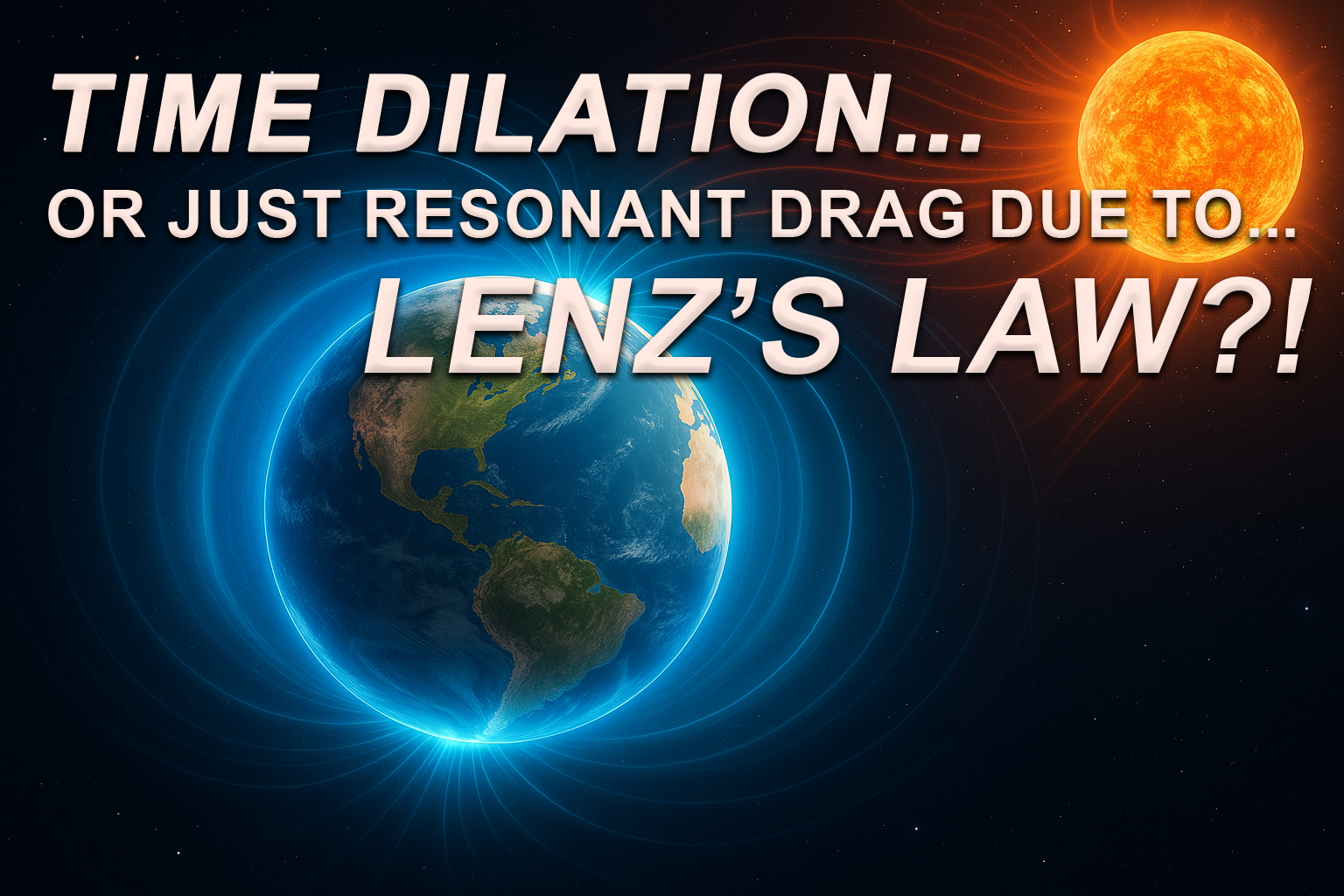Overview This document presents a robust alternative to Einsteinian time dilation, proposing that the apparent slowing of time at high velocities is not due to spacetime curvature or relativistic effects, but instead arises from electromagnetic feedback mechanisms described by Lenz’s Law within ionized plasma environments. This interpretation reconsiders core scientific observations such as muon decay, atomic clock shifts, and satellite synchronization not as relativistic phenomena, but as the result of instrument-environment interactions in charged plasma media.
1. Time Dilation and Its Observational Basis Three of the most cited empirical demonstrations of time dilation include:
- Muons reaching Earth’s surface despite short half-lives (HyperPhysics, n.d.)
- Atomic clocks on airplanes gaining or losing time depending on flight direction (Hafele & Keating, 1972)
- GPS satellites requiring relativistic corrections to maintain precision (Pogge, n.d.)
Each of these experiments is observationally sound—but the interpretation of those results is what this model reimagines.
2. Lenz’s Law in a Charged Atmospheric Medium According to Lenz’s Law, any change in magnetic flux through a conductor induces a current that creates a magnetic field opposing that change. When applied to plasma—which behaves as a conductive medium—objects moving through it induce feedback fields that resist the object’s motion.
Deng, Yin, Zhou, and He (2020) demonstrated that large currents in conductive systems generate significant magnetic fields, creating inductive loads and feedback loops. Such mechanisms are intensified in a plasma medium and provide a real-world precedent for electromagnetic opposition influencing instrumentation.
3. Muon Lifetime Extension Explained Mainstream science interprets the survival of fast-moving muons as relativistic time dilation. This model proposes:
- Muons travel through a gradient of increasing plasma density and wave pressure as they descend.
- Interactions with Earth’s ionosphere and embedded ULF/ELF wave structures modulate their decay pathways.
- Their decay products, governed by resonance and field interference, last longer due to EM opposition rather than time itself slowing.
4. Atomic Clock Flight Shifts: A Lenzian View In the Hafele–Keating experiment, clocks aboard airplanes showed measurable shifts:
- Eastbound clocks lost time; westbound clocks gained time. This framework suggests:
- Eastward motion (with Earth’s rotation) increases plasma-relative velocity, inducing stronger opposing fields in the clocks’ circuitry.
- Westward motion reduces this velocity differential, resulting in less EM opposition.
- The time shift is not intrinsic, but environmental—a response to directional impedance in a wave-rich, ionized medium.
Supporting this, research by Oliva and Ashcroft (1984) on acoustic plasma modes in two-component plasma systems confirms that wave interactions can create unique transport phenomena, which may affect how electronics operate within moving conductive fields.
5. GPS Time Corrections in Plasma Context GPS satellites function in the thermosphere and inner magnetosphere, where they are immersed in solar plasma, Langmuir oscillations, and Alfvén waves. Standard relativistic corrections (+38 microseconds/day) are required due to both high velocity and weaker gravity. In this reinterpretation:
- These shifts are corrections for resonance drag and impedance within the satellite’s electronic systems.
- Phase drift occurs due to ongoing interaction with the ionized solar wind and Earth’s field-aligned currents (Birkeland currents).
- Rahbarnia, Cazzola, Ebrahimi, and Forest (2024) showed that magnetized plasma can tolerate significant steady-state voltage differentials internally, reinforcing the idea that plasma can affect internal electronic timing.
6. Instrumental vs. Fundamental Time This distinction is key:
- Einsteinian view: Time is fundamentally relative and warped by speed and gravity.
- Plasma-based view: Time is absolute, but clocks—being wave-based devices—are affected by medium-induced phase interference.
Just as sound changes pitch through moving air (Doppler effect), so do electronic oscillations shift in a moving plasma. The result is an observational illusion of “time dilation” driven not by spacetime but by wave-medium interaction.
7. Experimental Consistency with Plasma Dynamics Scientific studies have shown that:
- The ionosphere conducts currents and reflects radio waves (NOAA, n.d.).
- Magnetic reconnection acts as an energy transfer process, influencing plasma heating and electronic behavior (Kusano, Inoue, & Bamba, 2022).
- Langmuir waves, ULF/ELF resonances, and magnetosonic interactions shape space weather and satellite operation (NASA, 2023).
Each of these validated observations reinforces the plausibility that charged media—not geometric abstractions—are driving the clock rate changes observed in aerospace environments.
Conclusion Time dilation, in this reinterpretation, is not a warping of spacetime but a tangible electromagnetic effect driven by Lenz’s Law and wave-based impedance in plasma environments. High-speed motion through the Earth’s ionosphere or solar plasma induces EM feedback fields that alter oscillatory behavior in timing devices. This recontextualization maintains the accuracy of observational data while replacing the abstract framework of relativity with a physically grounded, wave-mediated mechanism more consistent with plasma dynamics and electromagnetic theory.
References
Deng, Z., Yin, Z., Zhou, X., & He, Y. (2020). Magnetic field generation and magneto-electrical effects in electric current-assisted sintering. Metals, 10(12), 1653. https://doi.org/10.3390/met10121653
Hafele, J. C., & Keating, R. E. (1972). Around-the-world atomic clocks: Predicted relativistic time gains. Science, 177(4044), 166–168. https://doi.org/10.1126/science.177.4044.166
HyperPhysics. (n.d.). Muon decay and time dilation. Georgia State University. Retrieved from https://hyperphysics.phy-astr.gsu.edu/hbase/Relativ/muon.html
Kusano, K., Inoue, S., & Bamba, Y. (2022). Magnetic reconnection and its role in space and laboratory plasmas. National Institutes of Natural Sciences. https://www.ncbi.nlm.nih.gov/pmc/articles/PMC9616926
NASA. (2023). THEMIS mission: Studying Earth’s magnetosphere. National Aeronautics and Space Administration. https://www.nasa.gov/mission_pages/themis
NOAA. (n.d.). Ionospheric disturbances and space weather. National Oceanic and Atmospheric Administration. https://www.swpc.noaa.gov/phenomena/ionospheric-disturbances
Oliva, J., & Ashcroft, N. W. (1984). Acoustic plasma modes in a two-component Fermi liquid. Physical Review B, 29(2), 1067–1070. https://doi.org/10.1103/PhysRevB.29.1067
Pogge, R. (n.d.). How GPS accounts for relativity. Department of Astronomy, The Ohio State University. https://www.astronomy.ohio-state.edu/pogge.1/Ast162/Unit5/gps.html
Rahbarnia, K., Cazzola, E., Ebrahimi, F., & Forest, C. B. (2024). Electrostatic potential gradients in rotating magnetized plasma. Nature Communications, 15, Article 324. https://www.nature.com/articles/s41467-024-47386-2
Tags:


Leave a Reply